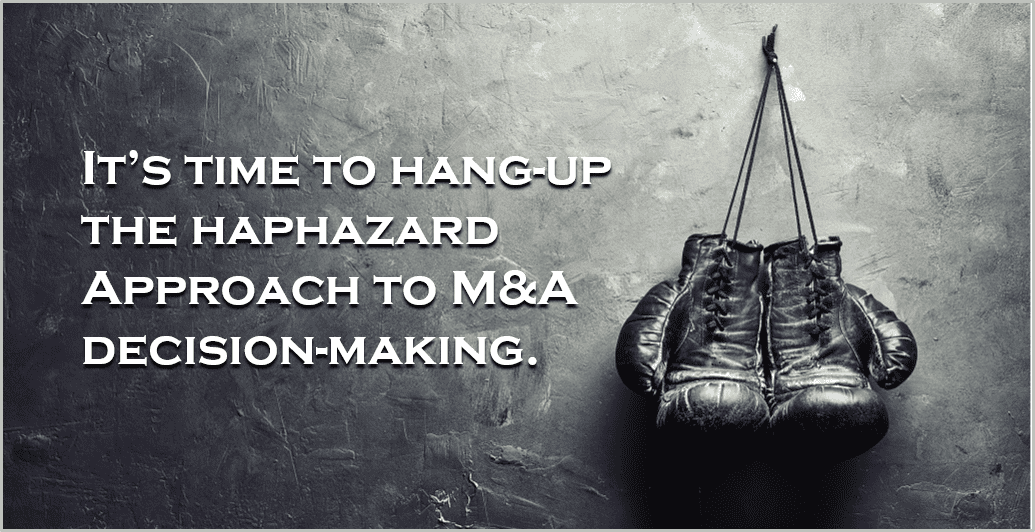Mergers & Acquisitions: Moving from Haphazard to Fact-Based Decision-Making

Mergers and acquisitions (M&A) is a component of corporate strategy that deals with the combining, buying and selling of companies or assets to promote the growth of the enterprise in its sector. The combining of two companies can boost financial power, market share, and business activity — allowing the newly formed company to further develop and expand within its sector. It can also provide opportunities to synergize by driving efficiencies through economies of scale.
Statista reported that in 2017, the value of global M&A deals amounted to 4.74 trillion U.S. dollars. Yet study after study puts the failure rate of mergers and acquisitions somewhere between 70% and 90%.
Haphazard Process, Haphazard Decisions
The reasons for a 70% to 90% failure are many and varied, but it’s fair to say that it starts with a flawed decision-making process. Too often, the decision-making process is haphazard, which seems counter-intuitive given the strategic importance of M&A decisions. Simply put, a haphazard decision-making process yields haphazard decisions. Here are some of the most common symptoms of a haphazard approach:

- The lack of an M&A strategy that clearly articulates the strategic goal that is trying to be achieved, which results in an over emphasis of short-term growth at the exclusion of other important rationales
- The lack of decision criteria to measure the degree to which the potential target companies align with the strategy, often resulting in groupthink or emotional decision-making
- An isolated or silo’ed decision-making team that excludes key perspectives from within the organization, fostering a sense of distrust within the organization
- An incomplete due diligence process, or one that is not tied to the decision criteria
- An incomplete view of the M&A landscape, leading to tunnel vision on too few alternatives
- The motivation is driven by fear or desperation that results in a sense of “we have to do a deal” and “we’ve invested too much to turn back now”
A haphazard decision-making approach to evaluating candidate companies will almost certainly result in failure. It could also have a significant and long-lasting detrimental effect on the acquiring company. With the number of mergers and acquisitions expected to rise over the next few years, many acquiring companies are looking to move away from a haphazard approach to improve their M&A decisions. Here are three recommendations to help your company move to fact-based and consensus-based decision-making.
Set up a Governance Board
The first order of business, particularly in larger organizations and companies, is to set up a governance structure. This may take the form of an M&A review board comprised of cross-functional leaders and representatives who:
- Set and maintain the M&A strategy and policy
- Approve the M&A process and procedures
- Approve the mergers and acquisitions that best meet threshold criteria
- Allocate resources (funding and people) to formulate M&A recommendations
- Commission and retire M&A implementation teams
- Review the M&A performance and plans at periodic checkpoints
- Resolve issues arising from M&A implementation teams
Select Target Companies using a Decision Model
The task of selecting and managing target companies is a classic portfolio management challenge. There are many factors to consider, alternatives to evaluate, and decisions to be made. Here, an emphasis should be placed on analyzing available data and engaging internal stakeholders to leverage their experience, insights, and judgments. This is best handled by building one or more decision models to enable multi-criteria decision-making, as I discussed in my October 2017 blog Using Decision Models for Multi-Criteria Decision-Making.
In this example decision model, you will see that M&A analysis can be improved by building a decision model with a holistic set of criteria and measures, such as:

- Financials (backlog, debt, growth rate, long-term liabilities, growth rate, and revenue)
- Intellectual Property (data and algorithms, design patents, trademarks, and utility patents)
- Human Capital (education and experience, longevity with company, market influencers, and security clearances)
- Technology (branded solutions, core competencies, market sector)
- Synergies (cost avoidance, expense reduction, scalability)
During this phase, it’s not too early to begin to define “how” the integration will work, even if at a conceptual level. Once there is agreement on the conceptual approach, representatives from both companies should define how the parties will work together by collaborating on the business process and procedures.
Manage M&A as a Portfolio
In closing, to successfully manage an M&A program and out-perform the 70-90% failure rate, an acquiring company must have a governance and management commitment commensurate with the investment and risk levels associated with the program. That commitment should include using proven portfolio management methodology, and multi-criteria decision-making models to build group consensus and make fact-based decisions.
© 2018 Definitive Business Solutions. All Rights Reserved.
John Sammarco has thirty-five years of experience leading, managing, and consulting to top public and private sector organizations, and has over twenty years of experience in facilitating complex group decisions. John founded Definitive Business Solutions in 2003, which provides world-class group decision-making solutions to increase efficiency, boost ROI, and reduce risk associated with business and technology investments. In 2016, John developed Definitive Pro™, which helps groups build consensus and make multi-criteria decisions.
